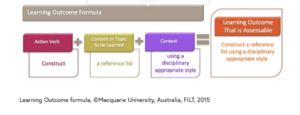A learning outcome is a succinct and clear statement of what students are expected to know, understand or be able to do, at the completion of a course and/or unit of study. Learning outcomes are not just statements about unit content, they also describe the skills that are valued in a discipline. Well-written learning outcomes demonstrate constructive alignment, that is, a connection between the aims of the course, the learning outcomes, the learning activities, the assessment, and the marking criteria. Students' achievements in relation to learning outcomes should always be measurable via the unit assessments.
Learning Outcomes Guidelines
Keep in mind the following points when writing learning outcomes:
- Unit learning outcomes should align to the relevant Australian Qualifications Framework (AQF) level and associated taxonomies relevant to the field of study.
- Unit learning outcomes should match the expertise level of students (eg. first-year units will contain less advanced learning outcomes than a third-year units).
- Unit learning outcomes should use appropriate language (eg. avoid abbreviations and acronyms).
- Unit learning outcomes should not be too numerous (eg. more than eight) or too few (eg. less than five). There are exceptions, depending on the unit.
- Unit learning outcomes should not be unnecessarily repeated.
- Unit learning outcomes should be clearly measurable (ie. the skills students are required to attain must be measured in the unit assessments).
- Unit learning outcomes use at least one active verb per outcome, that is appropriate to the unit level/level of study. Refer to the Recommended Resources to see lists of suitable verbs based on Bloom's Taxonomy (Bloom, Engelhart, Furst & Krathwohl, 1956).
- Unit learning outcomes should be aligned with the broader course/major/specialty learning outcomes to which the unit belongs (ie. the unit learning outcomes fit within the broader learning outcomes of the associated course/major/specialty).
Learning Outcomes 'Formula'
A simple way to remember how to write learning outcomes is to refer to the following formula. The formula consists of action verb/s, deployed in relation to the content/topic to be studied, within a discipline-specific context.

Bloom's Taxonomy
Bloom's Taxonomy (revised by Krathwohl et al., 2000; Bloom, Engelhart, Furst & Krathwohl, 1956) is frequently referred to when writing learning outcomes since it provides a ready-made structure and list of verbs. The Taxonomy represents a hierarchical ordering of the cognitive skills that students are expected to acquire as a result of their studies. It is helpful to have the Taxonomy on hand when writing learning outcomes, as it will help to identify the ways by which students will be expected to demonstrate the skills connected to their learning.
Recommended Resources
The University's Learning Innovation Hub provides the following useful guides on how to write learning outcomes and link them to unit content.
